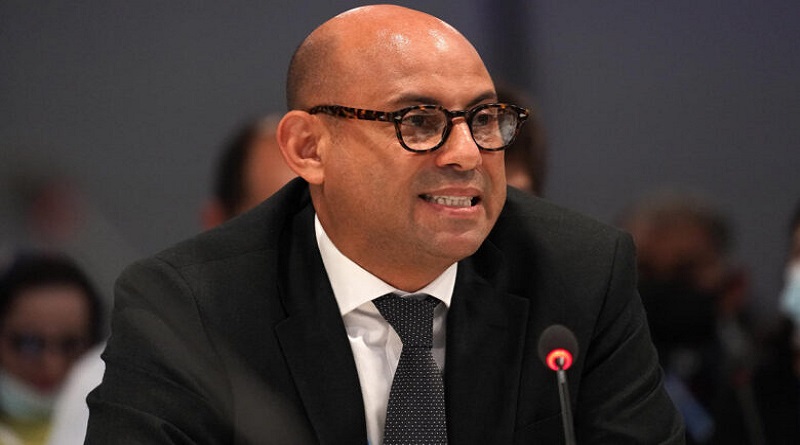Fashion industry needs to move further, faster to drive climate action- Stiell
The fashion industry needs to move “further and faster” to drive down emissions and prove the sector is serious about shifting from cosmetic to systemic change, said UN Climate Change Executive Secretary Simon Stiell.
Speaking at a two-day meeting of the Fashion Industry Charter for Climate Action in Bonn, Germany, last week, Stiell said some progress has been made – such as complying with basic reporting requirements, disclosing more climate-related information and collaborating with each other – but the sector still has a long way to go.
“It’s good — but it’s not good enough,” said Stiell. “After five years the fashion industry simply isn’t at the point where we can say that it is truly changing, and implementation is truly happening. Less than half of active signatories are compliant with setting climate targets needed to limit global heating to 1.5 degrees Celsius. By and large, their extensive supply chains aren’t aligned with Charter goals either. This is the reality.”
The Fashion Charter was set up with the support of UN Climate Change in 2018 to provide a pathway for the industry to achieve net-zero emissions by 2050, in line with global efforts to limit warming to 1.5C. Other commitments in the Charter include sourcing 100% of electricity from renewable sources by 2030, sourcing of environmentally friendly raw materials, and phasing out coal from the supply chain by 2030.
Since its inception, the Charter has seen progress on industry-wide climate ambition. This includes growing the signatory base to 101 companies, including Burberry, H&M Group, adidas, Chanel, Nike, and PUMA as well as suppliers such as Crystal International and TAL Apparel.
“What we’ve seen over the last four years is really to have climate action being very much transformed into the forefront of our agendas,” said Stefan Seidel, Head of Corporate Sustainability at PUMA. “We see large industry players, be it companies or also organizations, putting climate targets out there. And we see climate action or climate change being one of the major topics for discussion at nearly all industry meetings today. So we can really say that climate change has become a major topic in our industry within the last four years since the launch of the Charter.”
Charter members are expected to publicly report progress against interim and long-term targets annually, via CDP, a not-for-profit charity. Last year, 10 Charter signatories made it on to CDP’s A-List of Companies, demonstrating real leadership in the sector. CPD data shows that currently 45% of the Charter’s active signatories are compliant with setting public climate targets needed to keep global warming below 1.5C.
However, Stiell said fashion sector emissions remain “eye-wateringly high,” emitting the same quantity of greenhouse gases annually as the entire economies of France, Germany, and the United Kingdom combined.
“Clearly this sector needs to move further and faster,” said Stiell. “It needs to accelerate the pace of implementation of this Charter and extend its reach. Emissions need to go down as rapidly as possible.”
This is going to require a radical degree of collaboration, underpinned by accountability to make sure companies are following through on the pledges they’ve made.
“The fashion sector is extremely competitive and as someone who has spent a lot of time in the private sector, I fully appreciate what it takes to be here sitting amongst your competitors,” said Stiell. “But this is the only way of working if we are to get to where we need to go.”
Catherine Chui, Vice President of Corporate Quality and Sustainability with Crystal International, agreed, saying collective action strengthens the sector. Her company is one of the world’s largest garment manufacturers with 20 factories in five countries and an annual turnover of USD 2.1 billion.
“The Fashion Industry Charter provides a very good platform for us to work collaboratively with brands and other stakeholders to drive down emissions,” said Chui. “As a signatory and one of the steering committee members of the Fashion Charter, I also hope that I can work with more manufacturers and encourage them to join us and go this way.”
At the closing of the meeting, Charter members agreed that real change means collaborating more with suppliers and engaging the entire ecosystem – from cotton farmers to textile machinery producers. It means building partnerships beyond the sector as well, with the Charter’s working groups tasked with reaching out to stakeholders in areas such as policy, finance, transport and agriculture.
The Charter listed the next line of action to include: Bangladesh Policy Roundtable, 27 February 2023: A policy dialogue will be held in Dhaka, Bangladesh, to discuss opportunities for policy solutions in support of renewable energy scaling and the role of the private sector in supporting that transformation.
Fashion Industry Charter for Climate Action – Progress Report, 28 February 2023: An aggregate progress report of the Fashion Charter members’ climate disclosure will be published in collaboration with CDP.
UN Climate Change Conference (COP28), November/December 2023: The first global stocktake of the Paris Agreement will conclude at COP28. This will drive climate ambition towards 2030 by all governments and across all sectors. Fashion industry leaders are invited to join the stocktake process by submitting a list of actions that would make a transformational difference in the sector now and emerging opportunities for policymakers and other stakeholders.




